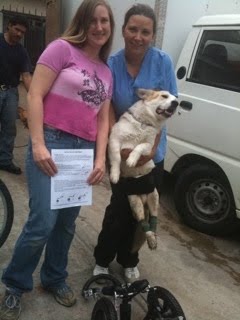Today’s guest post comes from my friend and colleague Dr. Sarah, whom I have known from blogging long before I knew her from her efforts with animal rescue. Today Sarah is talking a little more about a unique and amazing rescue I have featured in the past here on pawcurious, the Friends of Humane Society de Tijuana. With less resources and more challenges than most rescues stateside, this group of volunteers have accomplished SO much. And there is so much more to do. I hope you are as inspired by them as I have been.
Dr. V has been kind enough to blog about a couple of our ventures here on Pawcurious, including Project Beatrice and our recent rescue of Napoleon. However, I thought perhaps I could give you all a proper introduction to our organization, the Friends of Humane Society de Tijuana, as these projects represent only a small part of what we do. I have a dual purpose in telling you more about us: we are recruiting. I will explain in further detail below.
Friends of HSTJ is an American non-profit corporation that was begun a couple years ago to support the Humane Society de Tijuana, a Mexican non-profit. We are very fortunate in that we have a number of supporters on both sides of the border, all with the common goal of reducing the population of unwanted street animals in Tijuana, Mexico. We are a grass-roots organization that is led by a very small core group of Mexican and American volunteers, myself included.
 Much of our exposure on the American side has been associated more with adoptions and rescues, but these really aren’t the primary drivers for our organization. HSTJ does not currently have a shelter and probably will not be in a position to for some time. Although rescue is not our primary focus, we are a group of animal lovers, and inevitably we run across cases we have to take in. Our rescues are cared for by fosters on both sides of the border until they are adopted, and sometimes the logistics of international adoptions can be a little challenging. Napoleon is a case in point (he is still in need of a loving home, by the way). My own dog, Summer, is another (you can read about her harrowing story on our blog.
Much of our exposure on the American side has been associated more with adoptions and rescues, but these really aren’t the primary drivers for our organization. HSTJ does not currently have a shelter and probably will not be in a position to for some time. Although rescue is not our primary focus, we are a group of animal lovers, and inevitably we run across cases we have to take in. Our rescues are cared for by fosters on both sides of the border until they are adopted, and sometimes the logistics of international adoptions can be a little challenging. Napoleon is a case in point (he is still in need of a loving home, by the way). My own dog, Summer, is another (you can read about her harrowing story on our blog.
However, rather than rescue and adoption, we center our mission around spay/neuter campaigns and run low-cost sterilization clinics in community centers down in TJ, focusing on the poor areas of Tijuana. We also have ‘itchy-scratchy’ clinics that treat for parasites (internal and external) in these areas.
Eradicating parasites helps the animals in more subtle ways than just improving their health directly. We’ve found that the residents of these neighborhoods become increasingly willing to provide care for these animals once they are healthier and pose less of a risk to their families from an infectious disease standpoint. The Itchy Scratchy clinics have also been a fantastic avenue for education of the residents, many of whom know very little about caring for animals since Mexican society is generally not very focused on animal welfare as things stand today.
 Ultimately, we want to curb the overpopulation problem in Tijuana. While we definitely have an overpopulation of dogs and cats in the U.S. that has been a primary focus for many organizations throughout our country, it pales in comparison to what we see in Mexico and other third world countries.
Ultimately, we want to curb the overpopulation problem in Tijuana. While we definitely have an overpopulation of dogs and cats in the U.S. that has been a primary focus for many organizations throughout our country, it pales in comparison to what we see in Mexico and other third world countries.
Street dogs are everywhere, and the vast majority of them are neither sterilized nor vaccinated. These animals are starving, suffering from mange, tick-borne diseases, and viruses that we rarely see in the U.S. Transmissible Venereal Tumor (TVT), which Dr. V posted about a while back, is rampant there as it is a sexually transmitted disease. To make matters worse for these animals, the city of Tijuana conducts round-ups that result in certain death for all animals collected, and until very recently the primary mode of euthanasias was via electrocution. To get a better idea of what we frequently see down in TJ, this video really sums it up nicely:
All of this, of course, means that our organization has our work cut out for us. Until recently, there were other organizations running similar campaigns and working in parallel with us on this problem in Tijuana and its surrounding areas. However, we’ve been notified that as of the beginning of 2011 we will be the only one left. It is time for us to step it up. Our monthly sterilization clinics average around 50 dogs and cats per clinic, but estimates are that there are 7000 dogs and cats (probably more than that, realistically) roaming the streets of Tijuana on any given day. At our current rate, we are barely chipping away at the problem.
We need vets. Right now, we have a few vets from the San Diego area and from other parts of Southern California who come with us to our monthly clinics, but if we wish to start increasing our sterilization clinics then we need to recruit more. I am currently planning on getting in touch with the San Diego VMA in an attempt to recruit more help, but if there are others I can reach through Pawcurious, then that would be wonderful. We have a core group of Mexican vets down in Tijuana that work with us as well, but in general there are very few Mexican vets willing to donate their time to our cause.
If you would like to volunteer with us, even if you are not a vet, you can reach us through our website at www.friendsofhstj.org. If you are a vet and wish for more information, you are welcome to e-mail me directly at sarah@friendsofhstj.org. Also, I’d like to take this opportunity to say we appreciate all of your comments and support that our organization has received via Pawcurious on both Napoleon and on Project Beatrice.
-Dr. Sarah






Could not watch the video. When the music started and the first few dogs popped up, that was it for me. I do applaud what you do and your dedication! What an overwhelming job you have! I will definitely keep your organization in mind as I give what I can to help those who help the animals (especially dogs and cats) who need it most.
Yeah, that video can definitely bring a tear, especially if you can make it all the way to the end. It’s subtle, but many of the photos are actually ‘before’ and ‘after’ pictures of animals we’ve helped.
Thank you for posting this! I joined the “Rescue 400 Club” as a result of your moving post and urge everyone to do something for this amazing group!
Thank you! I know it’s just a small amount, but I think people have no idea how far that small amount goes to help us. Thank you so much for your contribution!
It is scary that something that is essentially a cup of designer coffee can make such a huge impact on a monthly basis! Thanks for you do.